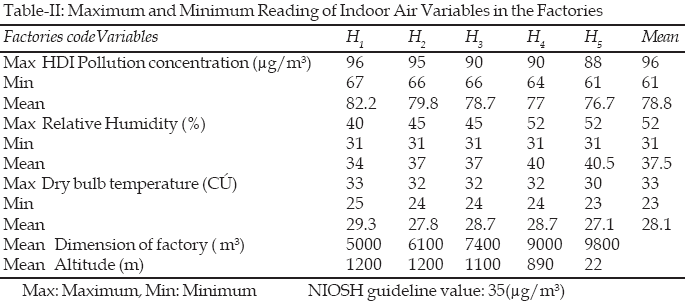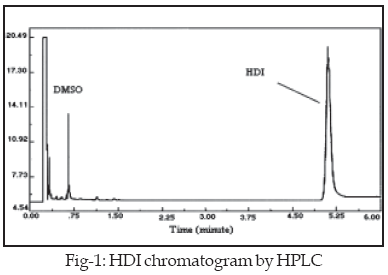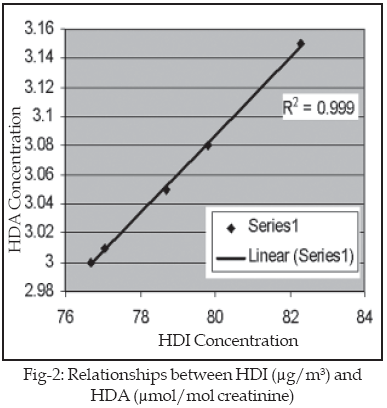|
|
||||
|
Published by : PROFESSIONAL MEDICAL PUBLICATIONS |
||||
|
ISSN 1681-715X |
||||
|
||||
|
- |
||||
|
ORIGINAL ARTICLE |
||||
|
- |
||||
|
Volume 25 |
July - September 2009 |
Number 4 |
||
|
|
||||
|
|
||||
|
|
||||
|
Published by : PROFESSIONAL MEDICAL PUBLICATIONS |
||||
|
ISSN 1681-715X |
||||
|
||||
|
- |
||||
|
ORIGINAL ARTICLE |
||||
|
- |
||||
|
Volume 25 |
July - September 2009 |
Number 4 |
||
|
|
||||
|
|
||||
Risk assessment of hexamethylen diisocyanate and
Hexamethylene diamine in the Polyurethane factories
Mirtaghi Mirmohammadi1, M.H. Ibrahim2,
A. Ahmad3,
M.O. A. Kadir4, M.Mohammadyan5, S.B.Mirashrafi6
ABSTRACT
Objectives: To determine the risk assessment of diisocyanate for workers and HDI concentration in the indoor air.
Methodology: For air monitoring 100 air samples were obtained using National Institute of Occupational Safety and Health (NIOSH) 5522 and for biological monitoring 50 urine samples were collected from the workers and analyzed with using William’s biological analysis method.
Results: The results showed high maximum concentration of hexamethylene diisocyanate (more than 88µg/mł) when compared to the NIOSH standard and high concentration of hexamethylene diamine in the worker’s urine.
Conclusions: Multiple regression models were obtained to predict of HDI risk in the polyurethane factories.
KEY WORDS:
ISO Cyanates, Polyurethane, Hexamethylene Diisocyanate, Hexamethylene Diamine, Occupational Health.Pak J Med Sci July - September 2009 Vol. 25 No. 4 613-618
How to cite this article:
Mirmohammadi M, Ibrahim MH, Ahmad A, Kadir MOA, Mohammadyan M, Mirashrafi SB. Risk assessment of hexamethylen diisocyanate and Hexamethylene diamine in the Polyurethane factories. Pak J Med Sci 2009;25(4): 613-618.
1. Mirtaghi Mirmohammadi,
2. M.H. Ibrahim,
3. Ahmad A,
4. M.O. A. Kadir,
5. M.Mohammadyan,
6. S.B.Mirashrafi,
1-5: School of Industrial Technology,
University Sains Malaysia,
11800, Pulau Pinang,
Malaysia.
Correspondence
Dr. Mirtaghi Mirmohammadi,
Dept. of Occupational Health,
Faculty of Health,
Mazandaran University of Medical Sciences,
Mazandaran – Iran.
E-mail: mirtaghim@yahoo.com
* Received for Publication: September 13, 2008
* Revision Received: March 19, 2009
* 2nd Revision Received: June 25, 2009
* Final Revision Accepted: June 28, 2009
INTRODUCTION
The common feature of diisocyanates is the presence of two -N=C=O (isocyanate) functional groups attached to an aromatic or aliphatic parent compound.
1 Diisocyanates are used as a initial chemical material in different factories such as surface coatings, polyurethane foams, adhesives, resins, elastomers, binders, and sealants.2 In the polyurethane workplace there are aerosols of diisocyanates which has important to effect on workers.3 They can also be exposed to partial reaction of isocyanate-containing intermediates formed during polyurethane production.4 The main thing for volatization of diisocyanate is exothermic reaction in the air which is most important in the workplace.5 As exposure limits decrease, the volatility of solid materials becomes an issue.6 Many prepolymer and polyisocyanate formulations contain a small fraction (usually less than 1%) of un-reacted monomer.7 Exposure to isocyanates is irritating to the skin, mucous membranes, eyes, and respiratory tract.8 A worker suspected of having isocyanate-induced asthma/sensitization will exhibit the traditional symptoms of acute airway obstruction, e.g., coughing, wheezing, shortness of breath, tightness in the chest, and nocturnal awakening.9 HDI reacts rapidly with water, thus if there are more moisture in the hexamethylene diisocyanate (HDI) polyurethane factories, the HDI pollution will also be high. The psychrometric parameters such as indoor temperature and relative humidity is also related with isocyanates.10,11The objectives of this study was to determine the risk assessment of diisocyanate for workers and HDI concentration in the indoor air of polyurethane factories, and to determine of HDA level in worker’s urine as a isocyanate biomarker. Another objective was to see whether the psychrometric parameters (relative humidity and dry bulb temperature) and other factors (dimension of factories and altitude) relevant to factory had any effect on HDI pollution concentration. These are important for two reasons: (i) better understanding of isocyanates pollution situation at different workplaces with variety psychrometric condition, (ii) recognition of concentration of HDI from hexamethylene diamine (HDA) results in worker’s urine which is metabolite of HDI in urine.
METHODOLOGY
Regression tool was used to assess risk assessment for polyurethane factories. Data was obtained through questionnaires for health surveillance in relation to isocyanates. Health surveillance assessment was extended to all processes where significant exposure to isocyanates in the form of vapor or aerosol may occur. It was the employee’s responsibility to fill up health surveillance questionnaire. This surveillance questionnaire was carried out under the supervision of an occupational hygienist. Statistical analysis was carried out using one multiple regression model through SPSS for both air and urine data.
Y = B
0 - B1 D + B2 RH + B3 Td (1)Where:
Y = HDI concentration]
B
0, 1…= Regression coefficientsD= Dimension of workplace
RH= Relative humidity
Td= Dry bulb temperature
A lot of five polyurethane factories in Iran were selected which have about 500 workers, the factories producing foam or polyurethane foams and the workers are exposed to HDI through indoor air pollution. The air sampling and analysis of Isocyanates from indoor air were divided into four steps: collection, derivatization, sample preparation, identification.
5 Air sampling was performed according to US National Institute of Occupational Safety and Health (NIOSH) method 5522 for isocyanate in air. Air samples were collected at 2 l/min using a midget impinger sampler (SKC, Eighty Four, PA) and personal sampling pumps calibrated before and after sampling with a Dry Cal DC-Lite primary flow meter (Bios International Co., Pompton Plains, NJ). A KNAUER HPLC was used for air analysis, the HPLC equipment consisted of a high-pressure pump, a variable-wavelength UV detector and a loop injector, HPLC columns were made of stainless steel (200 mm long x 5 mm in inside diameter) packed with 5 m Nucleosil C 18.5 The air concentrations of HDI was monitored continuously by the midget impinger instrument using a Dimethyl Sulfoxide with Tryptamine reagent and the sampling time for HPLC analyses was one hour at an air flow rate of 2 I/min. A GCMS-QP 1000 EI/CI equipped with a Shimadzu auto sampler (AOC-9) was used for metabolite analysis of Diisocyanates. For enrichment and evaporation of solvent, a vacuum desiccators connected to an aspirating pump was used the apparatus was equipped with an electrically heated oven that had been designed and manufactured at our laboratory for centrifugation of the samples.All the factories used general ventilation in the workplaces and the air sampling of HDI was done using the midget impinger instrument (SKC). Calibration was performed as recommended by the manufacturer. For air sampling, SIBATA mini pumps were used; 25-ml midget impingers containing 20 ml of the sample medium (Dimethyl Sulfoxide with Tryptamine) were employed. Temperature and relative humidity was measured by an Asman hygrometer and thermometers. Fifty workers were studied; Williams’ urine sampling method was used for the subjects.
9 All the subjects had been exposed to isocyanates before ending work shift (after 4 hour work was started) a urine sample was poured into a test cap (Polystyrene). The urine samples were made acidic by the addition of 0.5 g Citric acid to urine samples 30 cc caps before sampling. The samples were frozen at -20 °C until analysis HDA were assayed using a GC.MS technique.12-16 A capillary GC method using selected ion monitoring (SIM) was applied for the analysis of MDA in urine,16 for all of the samples, 100µl of heptanediamine 1ěM and ethylenedianiline 5µM was added to urine (2ml) acidified with concentrated sulphuric acid (200µl). Tubes were capped and incubated at 100 oC for 90 minutes. hydroxide (2ml, 10M) and diethyl ether (4ml) were added after cooling and mixed for 20 minutes. Then samples were centrifuged and removed 3ml of each ether layer to a clean tube and was removed the solvent under nitrogen. Samples medium was derivatised in toluene (500µl) in closed tubes at 55oC for 1h, then the mediums were cooled and removed the derivatizing reagent under nitrogen and reconstitute in toluene (100µl). Finally, the samples were injected (1µl) splitless (350oC, 30 sec) into a capillary column (30m x 0.3 mm BP5 1µm).RESULTS
Regression analysis was used to assess health surveillance for isocyanates. The individual factors depend on workers health surveillance which has shown that it is clear that some of the evaluated factors associated with diisocyanates pollution are well defined.
The predictive regression model was obtained from Table-I for comparison between health surveillance factors and HDA, MDA and TDA risk of absorption by workers. In all cases only weight and symptoms of disease were significant. The predictive statistical modeling equations are as follows:

Regression model (R˛= 0.931) for HDA risk assessment was:
HDA Risk = 79.534 + 4.271 wt + 2.755 Disease symptoms
Air monitoring results showed that (Table-II) the mean concentration of HDI is 96µg/mł at all factories. The relative humidity at the five factories ranged from 34 to 40.5% and dry bulb temperature was from 27.1 to 29.3ÚC. Workplace dimension for 5 polyurethane factories (H
1 – H5) ranged from 5000 to 9900mł. Altitude for five factories ranged from 22 to 1200m.

A multiple regression model obtained from analysis of indoor air pollution factors and HDI pollution implies that there is a relationship between the increase of HDI concentration and psychrometric parameters. Based on Table-IV this prediction model at á level of .001 is significant for all of the parameters (p <.0001).
The resultant predictive regression model obtained from Table 3 with R˛ = 0.976 is:
HDI = 20.13 – 0.0001 D + 0.1 RH + 2.61 Td (2)

A positive sign for the regression coefficient in the fitted model indicates the direct relationship of the variables with HDI concentration, whilst the negative sign indicates the inverse relationship with HDI concentration in the polyurethane factories.

The level of isocyanate metabolites in urine is an indicator of how much isocyanate has been absorbed and how well the controls are working. Creatinine is found in everyone’s urine and can be used to adjust the level of HDA to compensate for dilute or concentrated urine. The guideline value for HDA level is 2 µmol/mol creatinine samples above this value is considered contaminated.
13-15There is a strong relationship between HDI and HDA (Fig-2). The regression statistical test was carried out for significant relationship between HDI air samples and urine samples from workers.

The biomonitoring predictive model was extracted from Table-IV (R˛= 0.999):
Y = 0.028 + X
HDA = 0.0536 HDI (3)

DISCUSSION
When comparing the present study with other studies where present conditions have been described, this study contributes on personal and hygiene conditions.
15 Isocyanates operation is usually done in a spray and molding process, with basic exhausts ventilation. Surprisingly, exposure levels during polyurethane operation and other task related isocyanates do not seem to be lower than those reported in the other studies. In addition, there was significant relationship in exposure levels between workers health surveillance factors (weight of workers and symptoms of disease) and concentration of absorbed isocyanates metabolite by workers, where hygiene conditions were also less controlled, which could be demonstrated. In this study mean concentration of HDA was 3.24µmol/mol creatinine, and this value was slightly close to that biological result of car repair shop but with small number of participants,12 and this value was almost lesser than those found in other studies,15 whereas Maitre17 measured a value of 12µmol/mol creatinine for HDI exposure at this concentration from a survey of workers. The mean concentration of HDA was 3.24µmol/mol creatinine, and this value was slightly close to that biological result of car repair shop in Sweden but with small number of participants,14 and this value was almost lesser than to those found in other studies, whereas Maitre measured a value of 12µmol/mol creatinine for HDI exposure at this concentration from a survey of workers.17CONCLUSION
Among five individual risk factors, two of them (weight of workers and symptoms of disease) had relationship with absorbed isocyanates metabolites. However, compared to other factors (age of workers, history of work and smoking situation), no significance was observed. The models also
showed that there is a strong relation ship between weight of workers in the polyurethane factories and appearance of symptoms of disease relevant to isocyanates on workers. Surprisingly, no significant effect was seen for the age of workers, smoking or non smoking and history of work.ACKNOWLEDGMENT
The authors gratefully acknowledge the technical support of the Ministry of Health and Medical Education of Iran, as well as Medical University of Mazandaran and the research and academic support of Universiti Sains Malaysia.
REFERENCES
1. Bello D, Streicher RP, Woskie SR. Evaluation of the NIOSH draft method 5525 for determination of the total reactive isocyanate group (Trig) for Aliphatic Isocyanates in auto body repair shops. J Environ Med 2002;4:351-360.
2. Jaecker-Voirol A, Pelt P. PM10 emission inventory in Ile de France for transport and industrial sources: PM10 re-suspension, a key factor for air quality. Environmental Modelling & Software 2000;15 (6e7):575e580.
3. Key-Schwartz RJ, Robert P, Streicher, Christopher M, Key-Schwartz R. Evaluation of recoveries of several prepolymeric isocyanate products using NIOSH Methods 5521 and 5522 (unpublished data). Cincinnati, OH: U.S. Dept. of Health and Human Services, Public Health Service, Centers for Disease Control and Prevention, National Institute for Occupational Safety and Health 1994.
4. Schlecht PC, Cassinelli ME. Determination of airborne isocyanate exposure. Chapter K. NIOSH manual of analytical methods, 4th ed. Cincinnati, OH: U.S. Department of Health and Human Services, Public Health Service, Centers for Disease Control and Prevention, National Institute for Occupational Safety and Health, DHHS (NIOSH) Publication No. 1994;94–113.
5. Roemmelt H, Fruhmann G. Respiratory and other hazards of isocyanates. International Archives Occupational Environmental Health 1994;66:141-152.
6. John White. MDHS 25 Revisited; Development of MDHS 25/3, the Determination of Organic Isocyanates in Air. Annals Occupational Hygiene 2006;50(1):15-27.
7. H. Tinnerberg, Sennbro CJ. Assessment of exposure to aromatic diisocyanates air or biological monitoring. IOHA 6th International scientific conference, 19-23/9 2005, Pilanesberg, South Africa 2005.
8. Wu WS, Stoyanoff RE, Szklar RS, Gaind VS. Application of tryptamine as a derivatizing agent for airborne isocyanate determination: part 3. Evaluation of total isocyanates analysis by high performance liquid chromatography with fluorescence and amperometric detection. Analyst 1990;115:801-807.
9. Tury B, Pemberton D, Robert E. Bailey. Fate and Potential Environmental Effects of Methylenediphenyl Diisocyanate and Toluene Diisocyanate Released into the Atmosphere. J Air & Waste Management Association 2003;53(1):61(6):61-66.
10. Woskie SR, Sparer J, Gore1 RJ, Stowe M, Bello1 D, Liu Y, et al. Determinants of Isocyanate Exposures in Auto Body Repair and Refinishing Shops. Ann Occup Hyg 2004;48(5):393-403.
11. HSE. Health and Safety Executive. Methods for the determination of hazardous substances; MDHS 25/3. Organic isocyanates in air. Sudbury UK: Health and Safety Laboratory 1999.
12. Williams NR, Jones K, Cocker J. Biological monitoring to assess exposures from use of isocyanates in motor vehicle repair. Occup Environ Med 1999;56:598-601.
13. Pemberton D, Tury B, Bailey RE. Fate and potential environmental effects of methylenediphenyl diisocyanate and toluene diisocyanate released into the atmosphere. J Air Waste Manag Assoc 2004;53(1):61-6. 12568254 (P,S,G,E,B)
14. Williams NR, Jones K, Coocker J. Biological monitoring to assess exposure from use of Isocyanates in motor vehicle repair. Occup Environ Med 2006;56:598-691.
15. Sparer J, Stowe MH, Bello D. Isocyanate exposures in autobody shop work: the SPRAY study. J Occup Environ Hyg 2004;1:570-81.
16. Maitre A, Berode M, Perdrix A, Romazini S, Savolainen H. Biological monitoring of occupational exposure to toluene diisocyanate. Int Arch Occup Environ Health 1993;65:97-100.
17. Maitre A, Berode M, Perdix A. Urinary hexane diamine as an indicator of occupational exposure to hexamethylene diisocyanate. Int Arch Occup Environ Health 1996;69:65-8.
HOME | SEARCH | CURRENT ISSUE | PAST ISSUES
Professional
Medical Publications
Room No. 522, 5th Floor, Panorama Centre
Building No. 2, P.O. Box 8766, Saddar, Karachi - Pakistan.
Phones : 5688791, 5689285 Fax : 5689860
pjms@pjms.com.pk